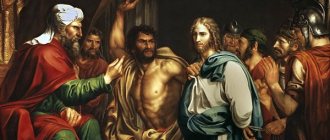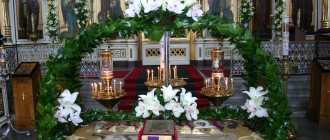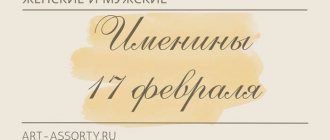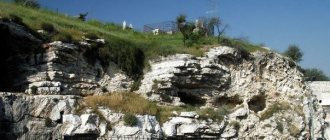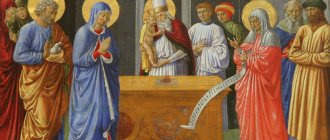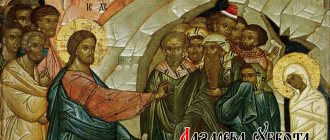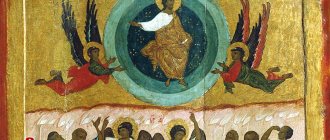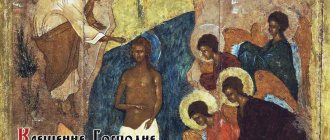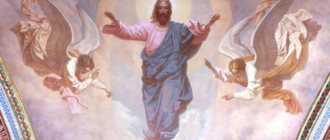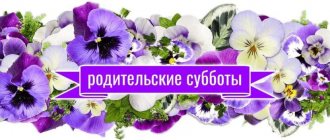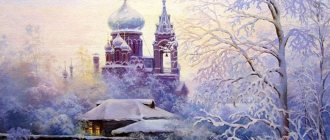Holy Saturday in Orthodoxy is a period of silence and waiting. The seven-week Great Lent and Holy Week are behind us. During this time, the Orthodox in prayer and fasting pacified their spirit, soul and body, filling themselves with the knowledge of the nature of God and the greatness of the sacrifice of Jesus Christ for the gift of eternal life.
On Holy Saturday, the hearts of Christians around the world freeze in anticipation of the Descent of the Holy Fire - the promise that the end of the world will not come within the next year, although no one knows the time of the second coming of the Messiah, only the Almighty God the Father.
Theology of Holy Saturday
The darkness of the night is still all around. It’s still so early in the world, That the stars in the sky have no number, And each one is as bright as day, And if the earth could, She would sleep through Easter while reading the Psalter.
Boris Pasternak's novel Doctor Zhivago, published in 1957 abroad, received there with a bang and translated into 24 languages in the first two years, was circulated in lists and illegal copies in the Soviet Union; it was first published for the Russian reader only in 1988, during perestroika. Because of this novel, Pasternak was subjected to severe persecution by the Soviet public and authorities. And many Russian cultural figures, scientists, and the political underground, who lived through that time, the 60s and 70s, the era of Khrushchev’s tyranny and Brezhnev’s stagnation, remember: Pasternak led us to Christianity. The poems he wrote on behalf of the main character, Yuri Zhivago, and added to the novel, for many people in an atmosphere of leaden atheistic pressure, became a window into Orthodox spirituality... One of the wonderful poems of this cycle is “On Strastnaya”, it is well known to thousands of readers, in Our days are included in school anthologies and anthologies of Christian poetry.
And from Holy Thursday until Holy Saturday, the Water drills the shores and creates whirlpools. And the forest is stripped and uncovered, And at the Passion of Christ, Like a line of worshipers, it stands in a crowd of pine trunks.
It is not easy for a reader well versed in Orthodox worship, its realities and features to determine exactly which day of Holy Week the poem refers to. It also contains signs of the weeks of Great Lent, when during the divine service, kathisma after kathisma, the entire Psalter is read repeatedly, and on Great Heel - the funeral procession of the cross with the Shroud takes place on Friday, and the same Psalter, especially the 17th kathisma of Psalm 118, traditionally read at burial... Well, “On Strastnaya” is a poetic work, and not an excerpt from the Typikon; it would be absurd to study the liturgical charter from it. Nevertheless, the main tonality of the poem is the tonality of Holy Saturday. A sad, quiet and beautiful day, when our Lord Jesus Christ is with His body in the tomb, but with His soul in the depths of hell, when our pain from the Calvary shocks of Friday is alive, but the unthinkable, heavenly hope for the Resurrection, on the morning of the new non-evening day of Christ, is already shines on us through sadness and silence. With this tonality, Pasternak’s poem reminds us of the biblical lines of the prophet Isaiah: “They shout to me from Seir : watchman, how long is it night? watchman, what time is it night? The watchman answers, “The morning is coming, but it is still night” (Isaiah 21 :11-12). It also reminds us of the position that the militant Church, the earthly Church, occupies now, in time and earthly history, a position that the Apostle Paul recalled and which everyone who considers himself a Christian should be aware of: “already” and “not yet,” the Kingdom of God is already came to us in power, the Resurrection has already been given to us - but we are still in the process of achieving it and aspiring, still fighting with sin and death for our freedom and eternal life in Christ, therefore with such hope we proclaim: “Maranatha” - “ Hey, come, Lord Jesus!”
Holy Saturday services retained a number of characteristic features of early Christian worship. They have a number of liturgical features: Great Saturday is the eve of Bright Resurrection; both mourning and festive Sunday features can be traced in the service of Great Saturday. According to the custom of the most important fast days, the Liturgy is celebrated after Vespers (as on Maundy Thursday and the Eve of the Nativity of Christ and Epiphany). According to tradition, for many centuries, it was on this day that the baptism of catechumens was performed, and therefore the service contains numerous Old Testament readings: 15 proverbs, 15 passages from the books of the Old Testament, from the book of Genesis to the prophecies of Daniel, read at Vespers, talking about the passion, the death and resurrection of the Savior, the son of God, and the coming glory of the New Testament Church. And at the Liturgy, instead of the Cherubim, the ancient hymn of the Jerusalem Church is sung: “Let all human flesh remain silent and stand with fear and trembling, and let nothing earthly think within itself: the King of kings and Lord of lords comes to sacrifice and be given as food to the faithful. And before Him come the faces of the Angels with all Principality and Power, the many-eyed Cherubim and the six-starred Seraphim, covering their faces and crying out the song: Alleluia, Alleluia, Alleluia.”
Photo: SPbDA/Flickr
Almost nothing is said in the New Testament about the fact that after the crucifixion and death of Christ with His soul descended into hell, except for the words of Christ Himself to the disciples: Just as Jonah was in the belly of the whale for three days and three nights, so the Son of Man will be in the heart of the earth for three days and three nights (Matthew 12:40 ), and some references in the apostolic epistles, for example: For Christ, in order to lead us to God, suffered once for our sins, the righteous for the unjust, being put to death in the flesh, but made alive in the Spirit, to whom He went and preached to the spirits in prison (1 Pet 3 :19-20). However, the idea that the Lord on the Sabbath day, having descended in soul to hell, preached there the message of the Kingdom of God and led the souls of the righteous to freedom, to paradise, where previously only the prophets Elijah and Enoch, taken alive to heaven, and also the prudent thief stayed , who confessed Christ on the cross, is one of the foundations of Orthodox teaching. This representation serves as a canonical iconographic plot of the Resurrection: the doors of hell's gates torn from their hinges are lying around, and Christ, in a special almond-shaped halo (mandorla), leads Adam, Eve and other righteous people from the depths of hell. The descent into hell is most fully described in the apocryphal “Gospel of Nicodemus” (III century). In Russia, on its basis, the Old Believers compiled the apocryphal collection “The Passion of Christ.” In this collection, in a separate chapter, “On the Resurrection of Christ and His Descent into Hell,” it is said that “Jesus Christ descended into hell, chasing the devil,” and there is a story describing the battle at the gates of hell (hell itself is symbolically described as some kind of animate being, an ally Satan). The devil turns out to be caught by Christ, who “led him into the underworld of the earth, into a woeful vale, and bound him with iron and irresolvable bonds, and sent him into an unquenchable fire and an unquenchable worm.”
Holy Saturday is a day full of peace and quiet. And the wind on this day subsides, the sky is silent, the earth is silent... But for us this is a day filled not only with sadness, but also with hope and expectation. Drops of holy water hang in the air, the priest passes by, blessing Easter cakes, eggs, and Easter food. It’s already evening, in the church they begin to read the Acts of the Apostles... And very soon we will sing: “Thy Resurrection, O Christ the Savior, the Angels are singing in heaven, and grant us on earth to glorify You with a pure heart.”
But at midnight, creation and flesh will fall silent, Having heard the rumor of spring, That as soon as the weather clears, Death can be overcome by the Effort of Resurrection.
What not to do on Holy Saturday before Easter in 2022 - advice from a priest
The day before Easter Sunday ends Holy Week. On Good Friday, Jesus Christ was crucified on the cross. The next day his body lay in the tomb. At this time, his close people and students were grieving. After all, they did not hope that the Savior would rise again. Therefore, Holy Saturday is a day of mourning.
Priests recommend giving up:
- any entertainment events;
- dancing;
- singing;
- organizing celebrations;
- carnal pleasures.
These restrictions explain another name for the Sabbath - quiet. Christians abstain from making any noise. Earthly passions are prohibited on Silent Saturday. There is no need to get irritated, quarrel with loved ones, or use foul language. It is necessary to manage time so that heavy work and household chores are completed in advance. The Sabbath is spent remembering the suffering and death of the Son of God.
What to eat on Holy Week
Table of what you can eat by day:
| Days of the week | Monday | Tuesday | Wednesday | Thursday | Friday | Saturday |
| What can you eat | Dry eating, honey, nuts, food without heat treatment, without adding oil | Dry eating, honey, nuts, food without heat treatment, without adding oil | Dry eating, honey, nuts, food without heat treatment, without adding oil | Dry eating, honey, nuts, food without heat treatment, without adding oil | Water | Dry eating, honey, nuts, food without heat treatment, without adding oil |
Holy Week: what is it, its meaning in Orthodoxy
Let's figure out what weeks are and what their essence is. In the Slavic tradition, this was the name for the seven-day cycle or week. In the dictionary this word is designated as obsolete and means 7 days. Believers come to churches to remember what happened these days many years ago.
The chronology of events preceding the main church holiday was as follows: first, the Last Supper took place, then the Savior of human souls was betrayed by one of his disciples, after which the trial took place. These days, the laity also remember the history of the terrible crucifixion of Christ and his burial. Every person who prays praises the Lord God for the fact that he was ready to die for the salvation of sinful human souls. People in their prayers ask for help and forgiveness of their sins.
Each day of Holy Week is called Great. The epithet Passionate can also be used (usually it is used to refer to Friday).
All the severity of Lent occurs during this time. The strictest prohibitions occur on Good Friday. In addition to the week, fasting includes the Holy Pentecost. The color of the vestments of church ministers these days is only black.
How to spend Holy Week. Customs
During Holy Week, it is recommended to visit churches. There the human soul finds peace, it is as close as possible to the Lord. Remembered during the days of Passion Week, the sufferings of Christ cleanse the soul and free it from sins. It is necessary to introduce into the morning and evening the rule of saying prayer words addressed to the Lord God.
It is no coincidence that the week is called holy. Despite the fact that you can do housework until Thursday inclusive, it is important to ensure that everyday life does not take over everyone’s thoughts. Every day it is worth remembering the great suffering of Christ, the torment he went through to save the souls of sinners.
Folk signs and beliefs on Holy Saturday
We all know that this holiday is especially dramatic. At this time, the body of the deceased Jesus Christ was removed from the cross to be placed in the tomb. For this reason, the day is not at all suitable for conflicts. Even if you have unpleasant feelings towards someone, you should save the emotions for the future. What could you do on this day?
- At this time, it was customary to complete all preparation procedures for the Feast of the Resurrection of the Lord. By this time, it was necessary to clean the house and prepare all the dishes that would be served on the festive table. To do this, they bought or prepared Easter cakes and painted eggs. If these procedures were not completed, they did not make a drama out of it. After all, only God is given the ability to accomplish many things in just a week, but man is not able to do everything. For this reason, continue to carry out your work with a clear conscience.
- This day is the last day when the vow limits people's food intake, and some indulgences are allowed on Saturday. It is allowed to drink a little wine with food, as well as eat hot food with vegetable oil.
- Limit your soul from unnecessary worries. During this period, it will be useful to ask for forgiveness from relatives and close friends. Do actions that will guide you on the true path. Everyone has their own recipe for achieving spiritual harmony. It is allowed to help the poor and needy.
- Believers go to temples. There they chant prayers to the Lord and bless Easter cakes.
- Until noon, visitors are allowed to visit cemeteries to clean up the graves of loved ones. At the same time, Sunday is not at all suitable for visiting the dead.
Questions and answers
| Is it possible to baptize children? |
| No, baptisms are not performed. |
| Is it allowed to celebrate a birthday? |
| Sitting modestly with close friends is not prohibited; cheerful festivities should be postponed. |
| Is it possible to get a haircut during Holy Week? |
| You can shorten your hair these days. |
| Can I have sex? |
| It is advisable to refuse any sexual relations. |
| What prayers should you read daily? |
| Every day involves reading a special prayer. |
| Is it possible to go to the cemetery? |
| No, it's better not to do this. |
| Why is Holy Week called this? |
| The name comes from the word passion, which in Church Slavonic means suffering. |
Holy Week 2022: when does it begin and end?
The last week of Lent in the calendar of Orthodox believers is marked in a special way. This time, following Palm Week, is given the name Holy Week. It includes six passionate days. Great Week begins on the Monday following Palm Sunday and ends on the Saturday before Easter Sunday.
Christians use several names that can be used to refer to Holy Week. Sometimes it is called holy week, for some this time is the Great Week, others say that the time is coming for the great week of Lent. The dates of the week are moving because they depend on the date of the celebration of the Great Feast.
In 2022, the week before Easter (Holy Week) starts on April 18, and on the eve of Passion Sunday, and on Saturday, April 23, it will end.
All days of the week have special meaning for Orthodox Christians.
What kind of day is Great (Holy) Saturday?
Holy Saturday is a time of quiet sorrow: the worst has already happened, Christ endured torment, ended his earthly life and lies in the tomb. But the sorrow is mixed with the joy of anticipation of what will invariably happen in the coming hours: Jesus will rise again, trampling down death by death.
This was preceded by the events of the night of Good Friday: after the crucified Jesus died on the cross, his body was removed, washed, anointed with incense, wrapped in a shroud and buried. According to Jewish custom, Jesus was buried in a cave not far from Golgotha, the place of his execution.
Jesus' persecutors, although they did not believe in his divine essence, were not completely calm. Therefore, as the Evangelist Matthew tells us, on Holy Saturday the high priests and Pharisees went to the procurator of Judea, Pontius Pilate, and reminded him of Jesus’ promise to resurrect in three days. The persecutors of Christ asked the representative of Rome to give orders to take the burial place of Christ under special control.
They feared that the apostles would steal the body of their teacher and tell his followers that Jesus had risen from the dead. Pilate left this to the discretion of the high priests, and by their order the entrance to the cave with the body of Jesus was blocked with stones, and a guard was placed there.
Further events occur on Sunday, that is, they are part of Easter. How did these events unfold?
After the Sabbath rest, the myrrh-bearing women go to the tomb of Jesus. At this moment an angel appears and descends on the coffin. An earthquake occurs and the stone covering the entrance to the tomb falls off. The guards tremble with fear, and the angel informs the myrrh-bearing women that Christ has risen.
This message is brought to the apostles by Mary Magdalene, who was the first to come to the tomb. The apostles rush to the tomb and are convinced that Jesus is not in it - only his mortal shroud remains there. The Apostle Peter enters the tomb, is convinced of the resurrection of Jesus and reports this to the rest of the apostles.
A brief description of these events can be seen here.
Signs
For a long time, Orthodox people have believed in omens. Which of them are the most significant:
- If you plant a plant on Monday, you will have a rich harvest in the summer.
- It will rain on Tuesday - there will be a lot of mushrooms in July. Sunny weather means wheat will grow.
- If you prepare special soap on Wednesday by Thursday, you will be healthy all year. In order for the soap to be useful, it was taken out to the doorstep and left there until the next morning.
- If you wash yourself on Thursday from a silver ladle or bowl, you will preserve your youth and beauty for a long time.
- Whatever the weather is like outside on Friday, that’s how it will be throughout the spring.
- If you visit the temple on Saturday, your life will be happy.
- The dream for Holy Week is considered prophetic. There is such an interpretation: if evil prevails in a dream, then you should be careful in life. Perhaps trouble awaits the person. A deceased relative in a dream reminds you that the time has come to remember him with a kind word.
Various signs were associated with the birth of a person and his death. It was believed that the souls of those who died during Holy Week would help their loved ones and become their guardian angels. Although there is an opinion that if a person dies at this time, it does not mean anything. It’s just that the date of death coincides with the great days. If the baby was born on the eve of Easter Sunday, then he will grow up cheerful, happy and resourceful.
Fasting on the Saturday before Easter: what you can eat
Holy Saturday is the only fast Saturday of the year. Since believers practically do not eat on Good Friday, they are allowed to eat on Saturday in order to withstand the night Easter service and celebrate Easter with dignity.
On Saturday, believers are allowed hot Lenten food without oil. But until the end of the service, all savory foods are strictly prohibited, and it is also forbidden to try ready-made Easter dishes.
For many, fasting is difficult, especially the last days, which are the strictest. But it is the one who passes the test who will be purified in spirit. After all, Easter will soon come, and everyone will greet each other with the words: “Christ is Risen” and “Truly Risen.”
history of the holiday
On the first day after the crucifixion and burial of Christ, early in the morning, the high priests, accompanied by the Pharisees, came to the procurator Pilate. They asked that a guard be placed at the tomb of Jesus so that the disciples would not steal the body and say that He had risen. Pontius allowed guards to be posted and a seal to be placed on the stone that covered the rock.
The disciples placed the body of the Savior in a new cave in the rock, where no one had been buried before. Guards confirmed that no one could have set foot in or out. This subsequently served as proof of a true miracle - the resurrection of the Son of God.
On the second day of his stay in the tomb, Jesus descended into hell and crushed its gates. He brought the light of the gospel sermon into the darkness of the underworld and announced the victory of good over evil. The Savior devastated hell, took Adam, Eve, and all the righteous with him and brought them to the heavenly abode. By descending into hell, Jesus completed His atoning torment for humanity.
Descent of the Holy Fire
Church services these days have their own characteristics, and this is not only a procession with the shroud, but also the ceremony of the descent of the Holy Fire (Holy Light). It takes place annually in the Church of the Holy Sepulcher in Jerusalem, and many believers consider it a miracle.
At about 3 p.m. Moscow time, the Holy Fire, which, according to Christian teaching, symbolizes the “true light,” is taken out of the edicule (in Latin: “peace, bedchamber”). This is a small marble chapel in the center of the rotunda of the Church of the Resurrection of Christ (Holy Sepulcher) in Jerusalem. The Edicule is erected over the tomb of Jesus and the side of the angel.
The ceremony of the descent of the Holy Fire into the Edicule symbolizes the resurrection of Christ. The priests and believers gathered in the temple are anxiously awaiting this moment.
From the fire brought by the Patriarch of Jerusalem, believers light candles, which illuminate the chapels of the temple. It is believed that in the first minutes the Holy Fire hardly burns and is healing.
Then the lamps, lit from the Holy Fire, are sent to Orthodox churches around the world, including Russia. A particle of fire is brought to the largest churches in Moscow, St. Petersburg and other cities. The ceremony is widely covered in the media.
